Abstract
We previously demonstrated the potent in vitro activity of erythromycin against Mycobacterium leprae as determined by its effect on ATP pools and rates of palmitate oxidation and phenolic glycolipid I synthesis. In the present study, the relative in vitro activities of a number of new macrolides with superior pharmacokinetic properties were assessed. In addition, for the most active compounds, concentrations in serum were determined by bioassay during continuous administration in the feed of mice, and in vivo activity against M. leprae was assessed by the kinetic mouse footpad technique. Both clarithromycin and roxithromycin were more potent than erythromycin in vitro, with the former showing the highest activity in accelerating rates of ATP decay and reducing rates of palmitate oxidation. In mice, concentrations of clarithromycin in serum were higher than those of roxithromycin and erythromycin, with the latter undetectable even when administered at 0.1% (wt/wt) in the diet. When administered at 0.01% (wt/wt) in the diet, erythromycin and roxithromycin were unable to inhibit growth of M. leprae in mouse footpads whereas clarithromycin demonstrated bactericidal-type activity. On the basis of these data and other properties of macrolides, a clinical trial of clarithromycin in leprosy is warranted.
Full text
PDF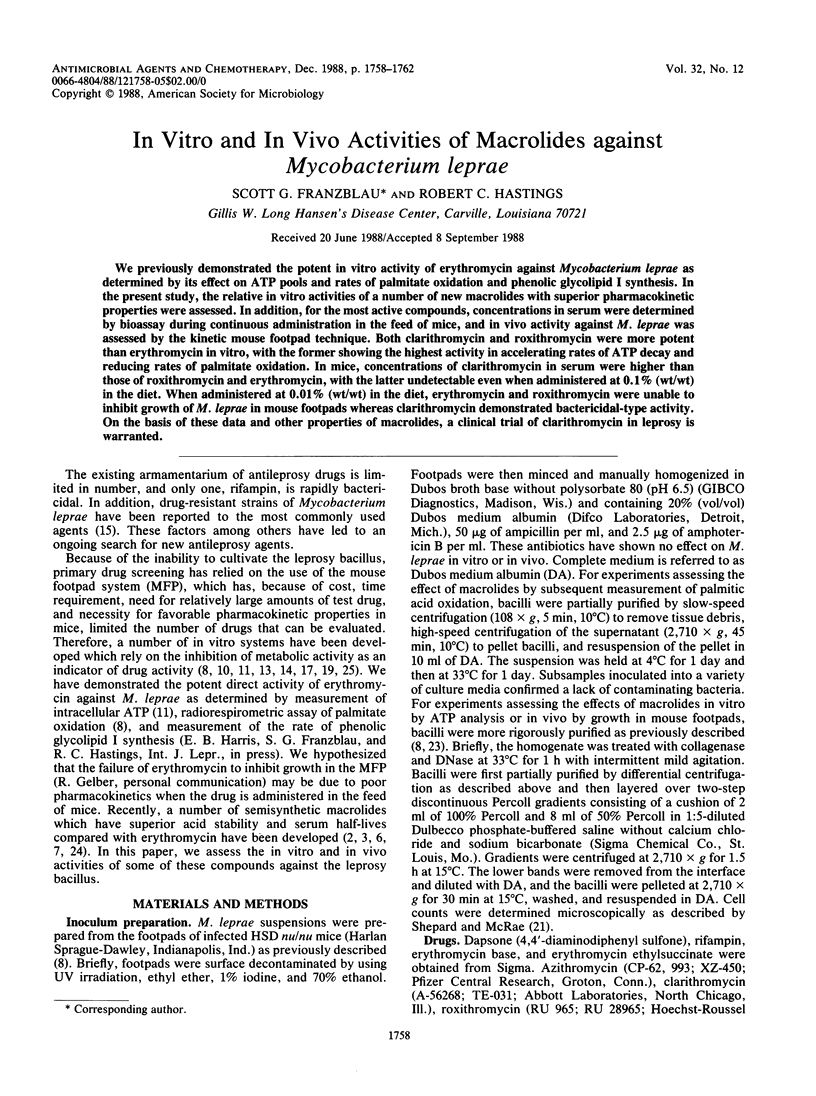
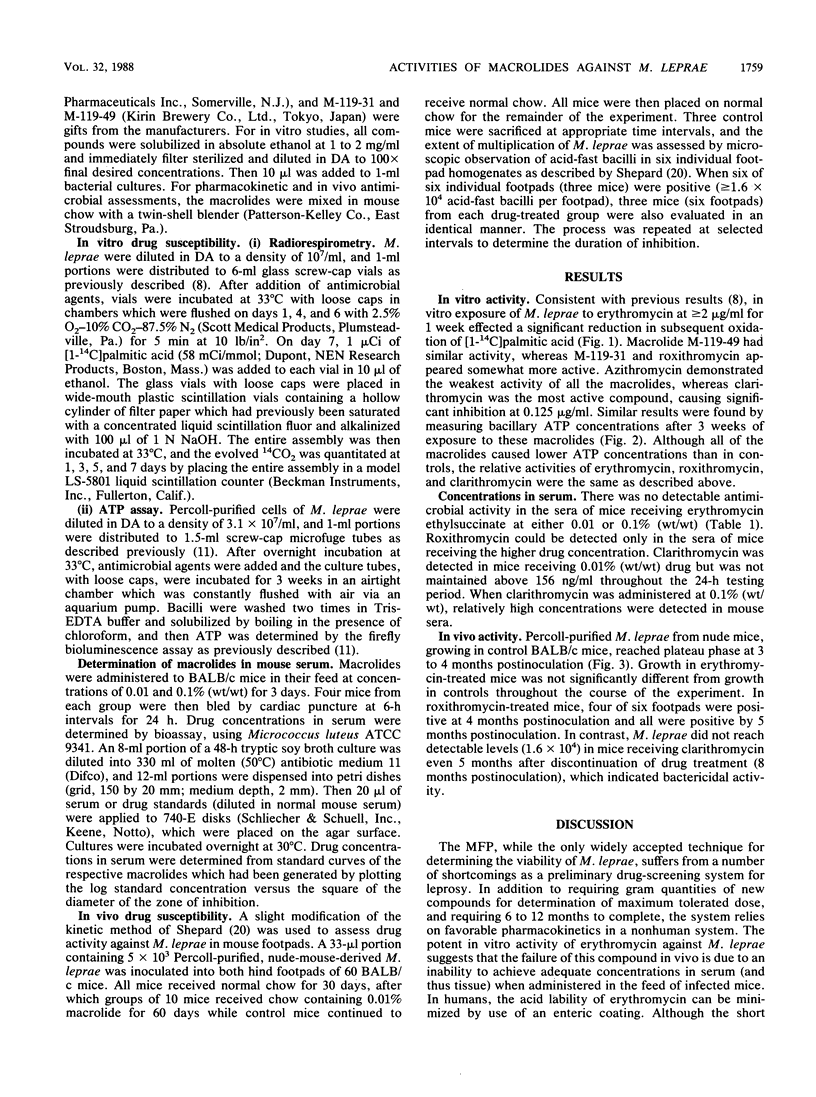
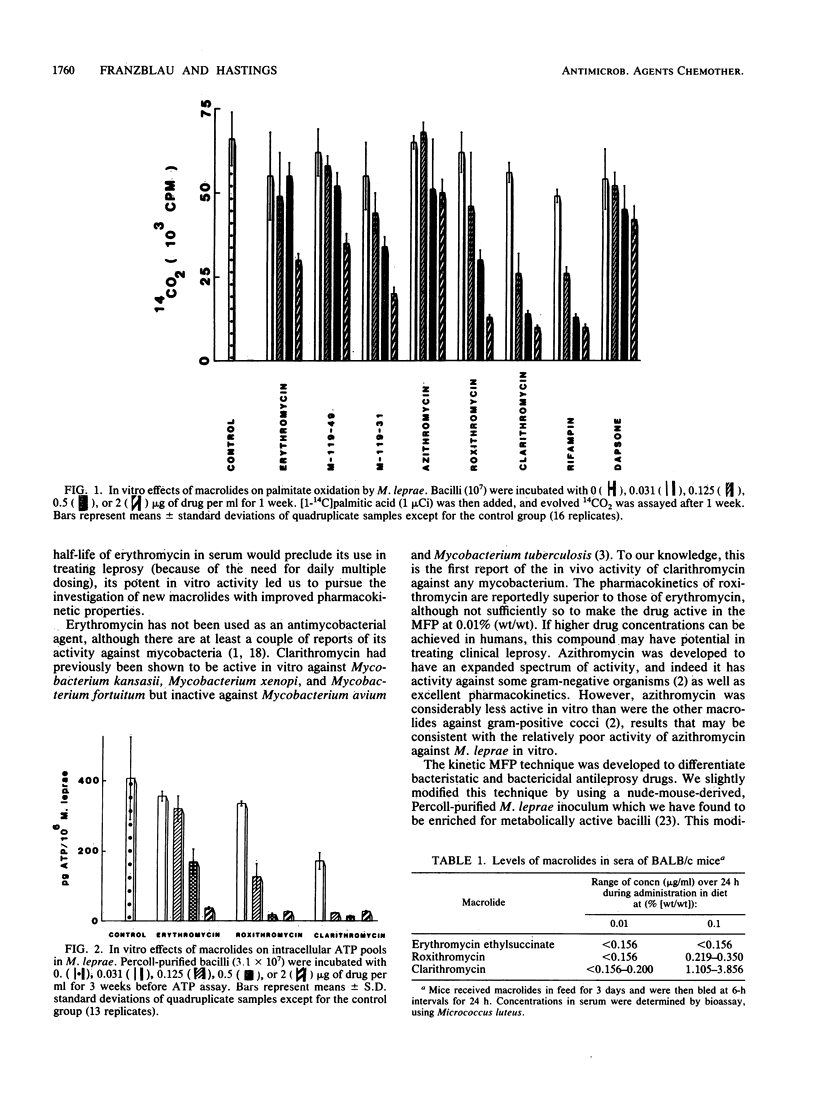
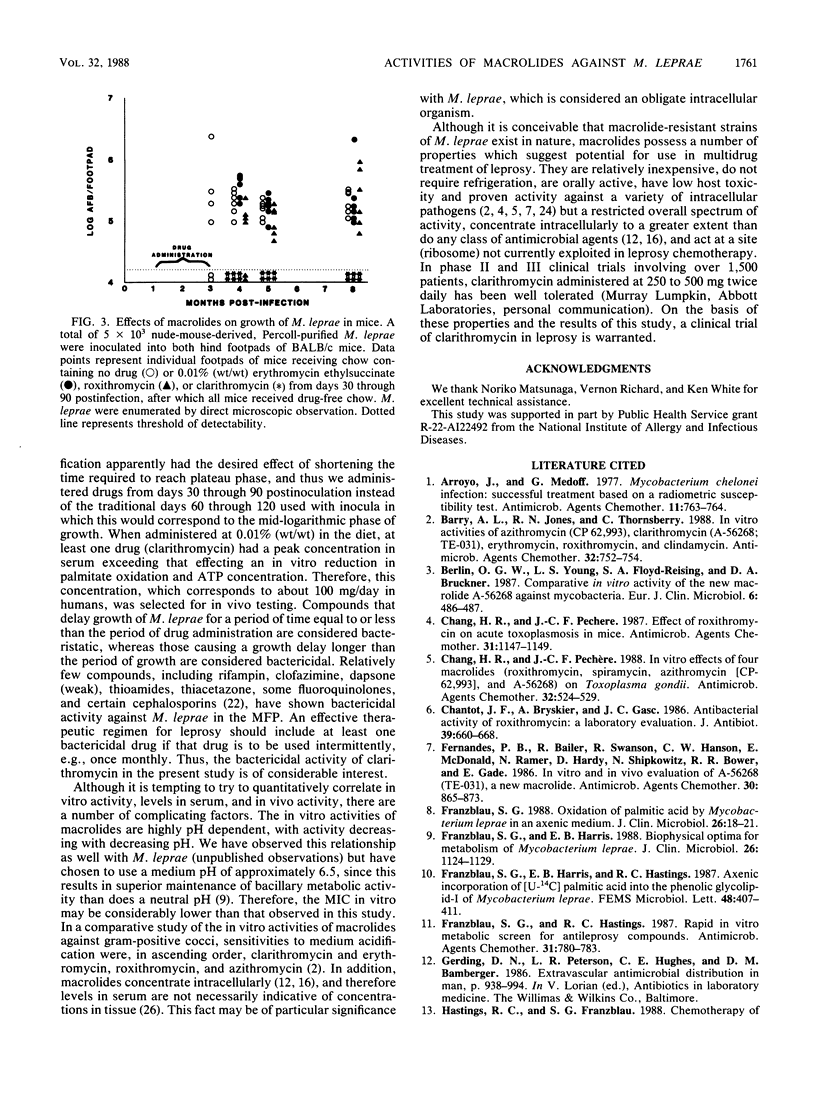
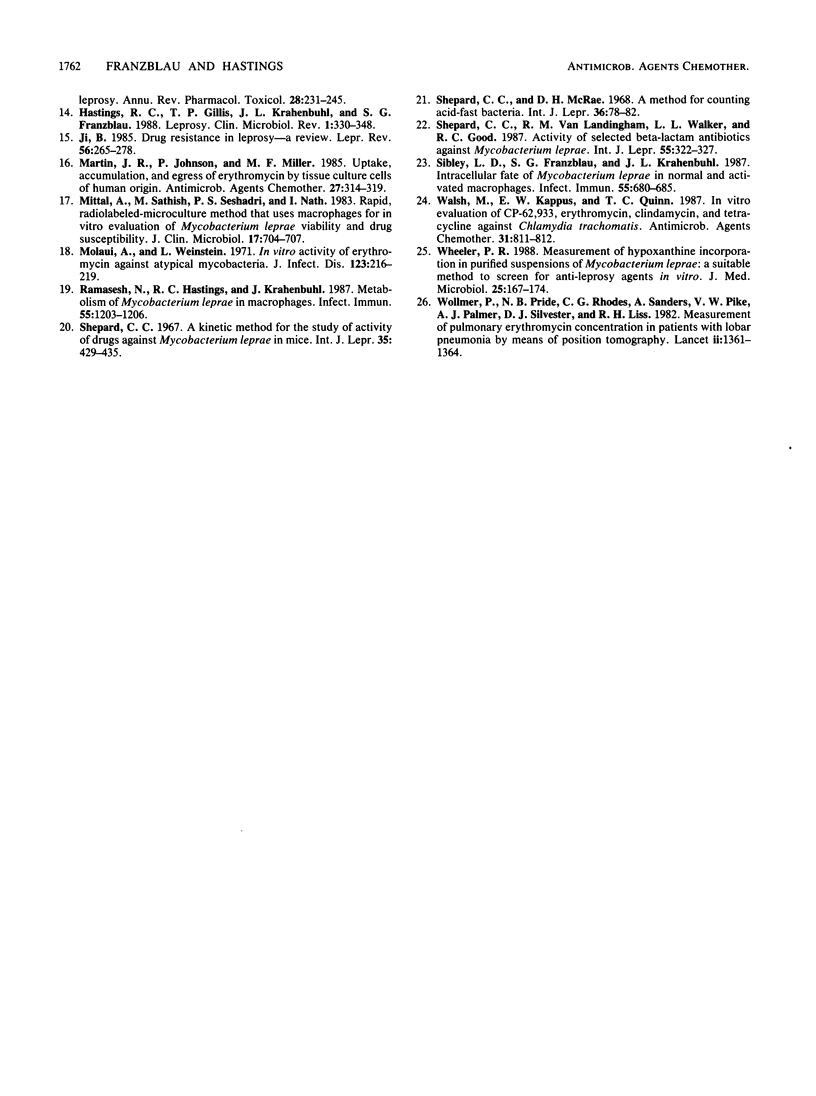
Selected References
These references are in PubMed. This may not be the complete list of references from this article.
- Arroyo J., Medoff G. Mycobacterium chelonei infection: successful treatment based on a radiometric susceptibility test. Antimicrob Agents Chemother. 1977 Apr;11(4):763–764. doi: 10.1128/aac.11.4.763. [DOI] [PMC free article] [PubMed] [Google Scholar]
- Barry A. L., Jones R. N., Thornsberry C. In vitro activities of azithromycin (CP 62,993), clarithromycin (A-56268; TE-031), erythromycin, roxithromycin, and clindamycin. Antimicrob Agents Chemother. 1988 May;32(5):752–754. doi: 10.1128/aac.32.5.752. [DOI] [PMC free article] [PubMed] [Google Scholar]
- Berlin O. G., Young L. S., Floyd-Reising S. A., Bruckner D. A. Comparative in vitro activity of the new macrolide A-56268 against mycobacteria. Eur J Clin Microbiol. 1987 Aug;6(4):486–487. doi: 10.1007/BF02013117. [DOI] [PubMed] [Google Scholar]
- Chang H. R., Pechere J. C. Effect of roxithromycin on acute toxoplasmosis in mice. Antimicrob Agents Chemother. 1987 Jul;31(7):1147–1149. doi: 10.1128/aac.31.7.1147. [DOI] [PMC free article] [PubMed] [Google Scholar]
- Chang H. R., Pechère J. C. In vitro effects of four macrolides (roxithromycin, spiramycin, azithromycin [CP-62,993], and A-56268) on Toxoplasma gondii. Antimicrob Agents Chemother. 1988 Apr;32(4):524–529. doi: 10.1128/aac.32.4.524. [DOI] [PMC free article] [PubMed] [Google Scholar]
- Chantot J. F., Bryskier A., Gasc J. C. Antibacterial activity of roxithromycin: a laboratory evaluation. J Antibiot (Tokyo) 1986 May;39(5):660–668. doi: 10.7164/antibiotics.39.660. [DOI] [PubMed] [Google Scholar]
- Fernandes P. B., Bailer R., Swanson R., Hanson C. W., McDonald E., Ramer N., Hardy D., Shipkowitz N., Bower R. R., Gade E. In vitro and in vivo evaluation of A-56268 (TE-031), a new macrolide. Antimicrob Agents Chemother. 1986 Dec;30(6):865–873. doi: 10.1128/aac.30.6.865. [DOI] [PMC free article] [PubMed] [Google Scholar]
- Franzblau S. G., Harris E. B. Biophysical optima for metabolism of Mycobacterium leprae. J Clin Microbiol. 1988 Jun;26(6):1124–1129. doi: 10.1128/jcm.26.6.1124-1129.1988. [DOI] [PMC free article] [PubMed] [Google Scholar]
- Franzblau S. G., Hastings R. C. Rapid in vitro metabolic screen for antileprosy compounds. Antimicrob Agents Chemother. 1987 May;31(5):780–783. doi: 10.1128/aac.31.5.780. [DOI] [PMC free article] [PubMed] [Google Scholar]
- Franzblau S. G. Oxidation of palmitic acid by Mycobacterium leprae in an axenic medium. J Clin Microbiol. 1988 Jan;26(1):18–21. doi: 10.1128/jcm.26.1.18-21.1988. [DOI] [PMC free article] [PubMed] [Google Scholar]
- Hastings R. C., Franzblau S. G. Chemotherapy of leprosy. Annu Rev Pharmacol Toxicol. 1988;28:231–245. doi: 10.1146/annurev.pa.28.040188.001311. [DOI] [PubMed] [Google Scholar]
- Hastings R. C., Gillis T. P., Krahenbuhl J. L., Franzblau S. G. Leprosy. Clin Microbiol Rev. 1988 Jul;1(3):330–348. doi: 10.1128/cmr.1.3.330. [DOI] [PMC free article] [PubMed] [Google Scholar]
- Ji B. H. Drug resistance in leprosy--a review. Lepr Rev. 1985 Dec;56(4):265–278. [PubMed] [Google Scholar]
- Martin J. R., Johnson P., Miller M. F. Uptake, accumulation, and egress of erythromycin by tissue culture cells of human origin. Antimicrob Agents Chemother. 1985 Mar;27(3):314–319. doi: 10.1128/aac.27.3.314. [DOI] [PMC free article] [PubMed] [Google Scholar]
- Mittal A., Sathish M., Seshadri P. S., Nath I. Rapid, radiolabeled-microculture method that uses macrophages for in vitro evaluation of Mycobacterium leprae viability and drug susceptibility. J Clin Microbiol. 1983 Apr;17(4):704–707. doi: 10.1128/jcm.17.4.704-707.1983. [DOI] [PMC free article] [PubMed] [Google Scholar]
- Molavi A., Weinstein L. In-vitro activity of erythromycin against atypical mycobacteria. J Infect Dis. 1971 Feb;123(2):216–219. doi: 10.1093/infdis/123.2.216. [DOI] [PubMed] [Google Scholar]
- Ramasesh N., Hastings R. C., Krahenbuhl J. L. Metabolism of Mycobacterium leprae in macrophages. Infect Immun. 1987 May;55(5):1203–1206. doi: 10.1128/iai.55.5.1203-1206.1987. [DOI] [PMC free article] [PubMed] [Google Scholar]
- Shepard C. C., McRae D. H. A method for counting acid-fast bacteria. Int J Lepr Other Mycobact Dis. 1968 Jan-Mar;36(1):78–82. [PubMed] [Google Scholar]
- Shepard C. C., Van Landingham R. M., Walker L. L., Good R. C. Activity of selected beta-lactam antibiotics against Mycobacterium leprae. Int J Lepr Other Mycobact Dis. 1987 Jun;55(2):322–327. [PubMed] [Google Scholar]
- Sibley L. D., Franzblau S. G., Krahenbuhl J. L. Intracellular fate of Mycobacterium leprae in normal and activated mouse macrophages. Infect Immun. 1987 Mar;55(3):680–685. doi: 10.1128/iai.55.3.680-685.1987. [DOI] [PMC free article] [PubMed] [Google Scholar]
- Walsh M., Kappus E. W., Quinn T. C. In vitro evaluation of CP-62,993, erythromycin, clindamycin, and tetracycline against Chlamydia trachomatis. Antimicrob Agents Chemother. 1987 May;31(5):811–812. doi: 10.1128/aac.31.5.811. [DOI] [PMC free article] [PubMed] [Google Scholar]
- Wheeler P. R. Measurement of hypoxanthine incorporation in purified suspensions of Mycobacterium leprae: a suitable method to screen for anti-leprosy agents in vitro. J Med Microbiol. 1988 Mar;25(3):167–174. doi: 10.1099/00222615-25-3-167. [DOI] [PubMed] [Google Scholar]
- Wollmer P., Pride N. B., Rhodes C. G., Sanders A., Pike V. W., Palmer A. J., Silvester D. J., Liss R. H. Measurement of pulmonary erythromycin concentration in patients with lobar pneumonia by means of positron tomography. Lancet. 1982 Dec 18;2(8312):1361–1364. doi: 10.1016/s0140-6736(82)91269-7. [DOI] [PubMed] [Google Scholar]


